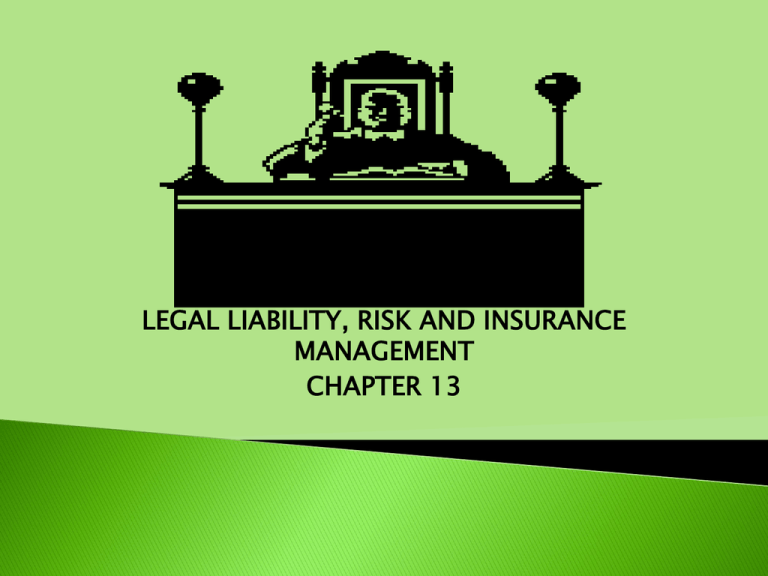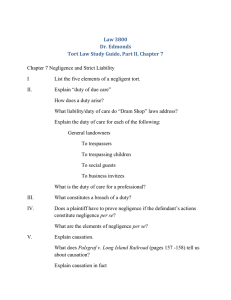TORT - Dr. H. Hamilton
advertisement

LEGAL LIABILITY, RISK AND INSURANCE MANAGEMENT CHAPTER 13 Legal Liability Tort Negligence Intentional Tort Product Liability Risk Management Insurance Management Liability is the responsibility, the state of one who is bound in law and justice to do something which may be enforce by action. Liability is the condition of affairs that gives rise to a legal responsibility, duty, or obligation to do a particular thing. Injuries occurs in: a. playgrounds b. sports field c. stands d. parks e. ski area f. golf courses g. gymnasiums h. arena i. natitoriums k. locker room l. classroom Physical Education & Sport Examples Class develop examples in the areas below. 1. 2. 3. 4. 5. 6. Sport Management & Exercise Science Examples OTHER LEGAL DEFINITIONS Tort comes from the Latin word meaning twist. Is a legal wrong resulting in direct or indirect injury to another person or property or to one’s reputation. A tort act is a wrongful act for which the court will award damages. TORT Negligence occurs when a professional does or fail to do an act that another person would be expected to do. (carelessness) For a person to be found negligent by the court: 1. duty 2. breach of duty owned 3. breach of duty owned causing injury. 4. proximate cause of injury 5. damage or harm that is measureable compensation. NEGLIGENCE Tort in physical education and sport: a. negligence b. supervisory negligence c. Intentional tort d. Product liability Review for Physical Education: Cardinal principles of supervision P. 416 Review for Coaches: Coaches guide to avoid charges of negligence P. 417 Intentional torts are injuries caused by an intended or deliberate act or failure to act. Battery, assault, and offensive touching are examples of intentional torts to persons. INTENTIONAL TORT Sport product liability is the liability of the anyone furnishing a defective product to the market/consumer. To sue for product liability, the injured part has only to prove the product caused the injury. PRODUCT LIABILITY I. The extent of the supervision: a. number b. type c. age d. fitness level 2. The quality of supervision: a. certification b. experience c. qualification Case Study: p. 421 Gifford vs. Grime Risk Management: Is an ongoing process of: a. b. c. d. e. f. g. Risk identification Evaluation Analysis Control as it relates to instruction Programming Supervision Operations Insurance Management: Schools and other organizations employ three major types of insurance to protect themselves. a. Protection of property Insurance b. Protection for liability c. Crime protection and other illegal acts. YOUR CALL History of Women in Sports TITLE IX GIRLS IN SPORTS 1923—Women's Division of the National Amateur Athletic Federation ◦ Opposed international competition ◦ Favored play days for girls and women ◦ “A sport for every girl, and every girl in a sport"— National Section on Women's Athletics Colonial period Next 100 years Late 1800s ◦ Horseback riding; dancing; fox hunting ◦ Riding; walking; dancing; calisthenics ◦ Croquet; cycling; hiking (with clothing restrictions) ◦ Tennis—1874 ◦ Gymnastics in bloomers 1892—Smith College (Senda Berenson) 1896—Stanford defeated California in the first intercollegiate game 1899—Standardized rules ◦ ◦ ◦ ◦ No snatching the ball Could hold ball only three seconds Could bounce ball only three times Divided court into three areas to limit exertion Basketball ◦ 1936—two-division game ◦ 1949—rover game in AAU; 1962 in colleges ◦ ◦ 1970—full court game in colleges Colleges—track and field; field hockey; archery; rowing; golf CONTRIBUTIONS OF BLACK COLLEGES TO WOMEN IN SPORTS Read Hamilton, H. (2005). The early emergence of women in physical activity and sports. 1. Who was the first HBCU to promote women’s sports team? 2. What was the first sport for women at an HBCU that excelled? 3. Who was the individual responsible and what was his position at the school? 4. Name another institution that made history with their women’s program? 5. What was the connection between the two HBCU schools? Increased Competition ◦ Olympic development thrust after defeat by Russians in 1956 and 1960 Olympic Games ◦ U. S. Olympic Development Committee in 1961—"to broaden the base of participation for girls and women in Olympic sports and to provide better experiences for the skilled athlete" ◦ 1963-1969—National Institutes on Girls' Sports—to train teachers and coaches ◦ Sanction intercollegiate events ◦ Hold national tournaments—first national tournaments in track and field and in gymnastics 1969—Association for Intercollegiate Athletics for Women ◦ NAGWS game rules ◦ 39 championships in 17 sports AIAW ◦ Members were colleges ◦ Educational goals and purposes ◦ AIAW Ended June, 1982 Because NCAA Members voted to bring in their women programs "No person shall on the basis of sex, be excluded from participation in, be denied the benefits of, be treated differently from another person or otherwise be discriminated against in any interscholastic, intercollegiate, club or intramural athletics offered by a recipient, or no recipient shall provide athletics separately on such basis." 1975—Federal government published guidelines for Title IX 1976—Schools and 1978 (colleges) required to be in full compliance with Title IX 1979—Congress adopted its policy interpretation of Title IX 1984—United States Supreme Court ruled in Grove City College v. Bell that Title IX was applicable only to educational programs that directly received federal funding TITLE IX “The law will bite if you are not in the right” Dr. H. Hamilton, Title IX Consultant Page 427 – Haffer vs Temple University Class action suit to obtain equity competitive opportunities, resources, and financial aid for women. Discrimination recruiting, coaching, travel, per diem, equipment, facilities, publicity, etc. Court ruled for Haffer. Page 428 – Cohen vs. Brown University School demoted two women teams to club status. Court found violations of title IX. Page 428 – Pederson vs. vs. Louisiana State University Suit against the Athletic Director and Chancellor for not providing opportunities for the women population of 49% vs. 51% men. AVOID LAWSUIT 1. Pre - participation Medical Examination Who should give them? 2. Health Insurance What type of insurance should the student have? What type of insurance should you have? What type of insurance should your school have? 3. Preseason Preparation How should you prepare? 4. Waivers and Consent- Acceptance of risk What does a waiver or consent form do? 5. 6. 7. 8. 9. Planning and Supervision Equipment-What is your responsibilities? Facilities- What is your responsibilities? Emergency Care- What should you be prepared to do? Records- Your records should reflect? REVIEW: Page 439 1. Have proper and current license. 2. Work within the scope. 3. Minimize danger. 4. Maximize supervision for safety. 5. Inspect facilities and equipment. 6. Document in writing proper authority about problems. 7. Activity must be approved. 8. Do not force student to do activity they cannot do. 9. Act promptly in circumstances. 10. Join a professional organization and get professional insurance. 11. Make sure athletes are covered. Law Terms Closer look at Negligence (Physical Education & Coach) History of Women’s Sport Title IX Contributions of HBCU Schools Lawsuit Avoidance List Safety Concerns Key Case Studies for Title IX





